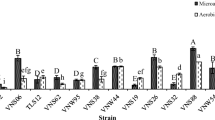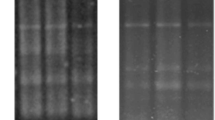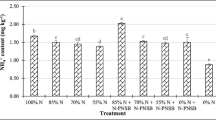Abstract
Aims
Purple nonsulfur bacteria (PNSB), Rhodopseudomonas palustris strains (TLS06, VNW02, VNW64 and VNS89), were investigated to increase rice growth and grain yield in acid sulfate soils (ASS) with low available phosphorus (Pavail).
Methods
P-solubilizers were tested in vitro. A 4 × 3 factorial design consisted of PNSB at 5.4 × 104 cells g−1 dry soil weight (mixture of 4 strains, VNW64 singly, or no-PNSB) and P fertilizer levels (0, 30, 45 and 60 kg P2O5 ha−1) that were used with the rice variety OM5451in pots with two types of ASS (Hon Dat and Phung Hiep).
Results
The four PNSB mixture had the ability to dissolve insoluble P from variscite and strengite. The combination of mixed culture with 45 P was the most effective, increasing grain yield by 34%. Enhancement of rice growth and yield in both soils corresponded to the maximal levels of Pavail, total P and NH4+, and the lowest levels of Alexch and Fe2+. Soil health with this treatment was significantly improved, with a strong positive correlation between PNSB population and phosphatase activity in both soil types.
Conclusions
The combination of PNSB mixture with P fertilizer reduced the amount of chemical fertilizer needed for maximal grain yield, provided safe rice, and maintained soil health.


Similar content being viewed by others
References
Ali B, Wang B, Ali S, Ghani MA, Hayat MT, Yang C, Xu L, Zhou WJ (2013) 5-Aminolevulinic acid ameliorates the growth, photosynthetic gas exchange capacity and ultrastructural changes under cadmium stress in Brassica napus L. J Plant Growth Regul 32:604–614
Alori ET, Glick BR, Babalola OO (2017) Microbial phosphorus solubilization and its potential for use in sustainable agriculture. Front Microbiol 8:971. https://doi.org/10.3389/fmicb.2017.00971
Arif MS, Shahzad SM, Yasmeen T, Riaz M, Ashraf M, Ashraf MA, Mubarik MS, Kausar R (2017) Improving plant phosphorus (P) acquisition by phosphate-solubilizing bacteria. In: Naeem M, Ansari A, Gill S (eds) Essential plant nutrients. Springer, Cham, pp 513–556
Bakhshandeh E, Rahimian H, Pirdashti H, Nematzadeh GA (2015) Evaluation of phosphate-solubilizing bacteria on the growth and grain yield of rice (Oryza sativa L.) cropped in northern Iran. J Appl Microbiol 119:1371–1382
Barrow NJ (2017) The effects of pH on phosphate uptake from the soil. Plant Soil 410(1–2):401–410
Brown JW (2013) Enrichment and isolation of purple non-sulfur bacteria. Department of Biological Sciences. College of Sciences. North Carolina State University. http://www.mbio.ncsu.edu/mb452/purple_nonsulfurs/purples.html. Accessed 15 Nov 2017
Cho MH, Kyaw N, Kyaw KW, Swe SM (2017) Assessment of soil indigenous nutrient supply as a natural resource management in rice production towards climate resilience agriculture. In Proceedings of the Tenth Agricultural Research Conference, Yezin Agricultural University, Nay Pyi Raw, Myanmar, 11–12 January 2017 (pp 159–177). Yezin Agricultural University
de la Luz Mora M, Demanet R, Acuña JJ, Viscardi S, Jorquera M, Rengel Z, Durán P (2017) Aluminum-tolerant bacteria improve the plant growth and phosphorus content in ryegrass grown in a volcanic soil amended with cattle dung manure. Appl Soil Ecol 115:19–26
Dou F, Soriano J, Tabien RE, Chen K (2016) Soil texture and cultivar effects on rice (Oryza sativa, L.) grain yield, yield components and water productivity in three water regimes. PLoS One 11(3):e0150549
Duarah I, Deka M, Saikia N, Boruah HD (2011) Phosphate solubilizers enhance NPK fertilizer use efficiency in rice and legume cultivation. 3 Biotech 1(4):227–238
Gupta DK, Chatterjee S, Datta S, Veer V, Walther C (2014) Role of phosphate fertilizers in heavy metal uptake and detoxification of toxic metals. Chemosphere 108:134–144
Harada N, Nishiyama M, Matsumoto S (2001) Inhibition of methanogens increases photo-dependent nitrogenase activities in anoxic paddy soil amended with rice straw. FEMS Microbiol Ecol 35(3):231–238
Horneck DA, Sullivan DM, Owen JS, Hart JM (2011) Soil test interpretation guide. EC 1478. Corvallis, OR: Oregon State University Extension Service
Huang Q, Tang S, Huang X, Yang S, Yi Q (2016) Characteristics of the acidity and sulphate fractions in acid sulphate soils and their relationship with rice yield. J Agric Sci 154(8):1463–1473
IRRI, International Rice Research Institute (2014) Standard procedure for determining yield components at harvest.< https://sites.google.com/a/irri.org/oryza2000/calibration-and-validation/experimental-data-collection-and-analysis/standard-procedure-for-determining-yield-components-at-harvest> (Accessed 8 Jan 2017)
Kantachote D, Nunkaew T, Kantha T, Chaiprapat S (2016) Biofertilizers from Rhodopseudomonas palustris strains to enhance rice yields and reduce methane emissions. Appl Soil Ecol 100:154–161
Kantha T, Kantachote D, Klongdee N (2015) Potential of biofertilizers from selected Rhodopseudomonas palustris strains to assist rice (Oryza sativa L. subsp. indica) growth under salt stress and to reduce greenhouse gas emissions. Ann Microbiol 65:2109–2118
Kelliher FM, Gray CW, Noble AD (2017) Superphosphate fertiliser application and cadmium accumulation in a pastoral soil. New Zeal J Agric Res 60(4):404–422
Khalimi K, Suprapta DN, Nitta Y (2012) Effect of Pantoea agglomerans on growth promotion and yield of rice. Agric Sci Res J 2(5):240–249
Khan MMA, Haque E, Paul NC, Khaleque MA, Al-Garni SM, Rahman M, Islam MT (2017) Enhancement of growth and grain yield of rice in nutrient deficient soils by rice probiotic bacteria. Rice Sci 24(5):264–273
Khuong NQ, Kantachote D, Onthong J, Sukhoom A (2017) The potential of acid-resistant purple nonsulfur bacteria isolated from acid sulfate soils for reducing toxicity of Al3+ and Fe2+ using biosorption for agricultural application. Biocatal Agric Biotechnol 12:329–340
Koh RH, Song HG (2007) Effects of application of Rhodopseudomonas sp. on seed germination and growth of tomato under axenic conditions. J Microbiol Biotechnol 17(11):1805–1810
Lakshmi KVNS (2012) Cultured diversity of purple anoxygenic phototrophic rhizobacteria of paddy and their plant growth promoting attributes (Doctoral dissertation, Jawaharlal Nehru Technological University, Hyderabad). Page:243
Liu Z, Rong Q, Zhou W, Liang G (2017) Effects of inorganic and organic amendment on soil chemical properties, enzyme activities, microbial community and soil quality in yellow clayey soil. PLoS One 12(3):e0172767
Madigan M, Cox SS, Stegeman RA (1984) Nitrogen fixation and nitrogenase activities in members of the family Rhodospirillaceae. J Bacteriol 157(1):73–78
Margenot AJ, Sommer R, Mukalama J, Parikh SJ (2017) Biological P cycling is influenced by the form of P fertilizer in an Oxisol. Biol Fertil Soils 53(8):899–909
Murphy J, Riley HP (1962) A modified single solution method for the determination of phosphate in natural waters. Anal Chim Acta 27:31–36
Nguyen NQ, Kantachote D, Onthong J, Sukhoom A (2018) Al3+ and Fe2+toxicity reduction potential by acid-resistant strains of Rhodopseudomonas palustris isolated from acid sulfate soils under acidic conditions. Ann Microbiol 68:217–228
Nunkaew T, Kantachote D, Kanzaki H, Nitoda T, Ritchie RJ (2014) Effects of 5-aminolevulinic acid (ALA)-containing supernatants from selected Rhodopseudomonas palustris strains on rice growth under NaCl stress, with mediating effects on chlorophyll, photosynthetic electron transport and antioxidative enzymes. Electron J Biotechnol 17(1):19–26
Nunkaew T, Kantachote D, Nitoda T, Kanzaki H, Ritchie RJ (2015) Characterization of exopolymeric substances from selected Rhodopseudomonas palustris strains and their ability to adsorb sodium ions. Carbohydr Polym 115:334–341
Onaga G, Dramé KN, Ismail AM (2016) Understanding the regulation of iron nutrition: can it contribute to improving iron toxicity tolerance in rice? Funct Plant Biol 43(8):709–726
Panhwar QA, Naher UA, Shamshuddin J, Othman R, Ismail MR (2016) Applying limestone or basalt in combination with bio-fertilizer to sustain rice production on an acid sulfate soil in Malaysia. Sustainability 8(7):700. https://doi.org/10.3390/su8070700
Panwichian S, Kantachote D, Wittayaweerasak B, Mallavarapu M (2010) Factors affecting immobilization of heavy metals by purple nonsulfur bacteria isolated from contaminated shrimp ponds. World J Microbiol Biotechnol 26(12):2199–2210
Perez E, Sulbaran M, Ball MM, Yarzabal LA (2007) Isolation and characterization of mineral phosphate-solubilizing bacteria naturally colonizing a limonitic crust in the south-eastern Venezuelan region. Soil Biol Biochem 39(11):2905–2914
Pradhan M, Pradhan C, Mohanty S (2017) Effect of P- solubilizing bacteria on microbial biomass P and phosphatase activity in groundnut (ArachishypogaeaL) rhizosphere. Int J Curr Microbiol App Sci 6(4):1240–1260
Ragot SA, Huguenin-Elie O, Kertesz MA, Frossard E, Bünemann EK (2016) Total and active microbial communities and phoD as affected by phosphate depletion and pH in soil. Plant Soil 408(1–2):15–30
Rengel Z, Marschner P (2005) Nutrient availability and management in the rhizosphere: exploiting genotypic differences. New Phytol 168:305–312
Richardson AE, Barea JM, McNeill AM, Prigent-Combaret C (2009) Acquisition of phosphorus and nitrogen in the rhizosphere and plant growth promotion by microorganisms. Plant Soil 321(1–2):305–339
Robinson GW (1922) A new method for the mechanical analysis of soils and other dispersions. J Agric Sci 12(3):306–321
Rossolini GM, Schippa S, Riccio ML, Berlutti F, Macaskie LE, Thaller MC (1998) Bacterial nonspecific acid phosphohydrolases: physiology, evolution and use as tools in microbial biotechnology. Cell Mol Life Sci 54(8):833–850
Sakpirom J, Kantachote D, Nunkaew T, Khan E (2017) Characterizations of purple non-sulfur bacteria isolated from paddy fields, and identification of strains with potential for plant growth-promotion, greenhouse gas mitigation and heavy metal bioremediation. Res Microbiol 168:266–275
Soman C, Li D, Wander MM, Kent AD (2017) Long-term fertilizer and crop-rotation treatments differentially affect soil bacterial community structure. Plant Soil 413(1–2):145–159
Soomro AA, Abro MA, Leghari N, Leghari GM, Soomro AA (2015) Evaluation of aluminum toxicity tolerance in rice (Oryza sativa L.). Sci Int 27(3):2251–2255
Spagnoletti FN, Tobar NE, Di Pardo AF, Chiocchio VM, Lavado RS (2017) Dark septate endophytes present different potential to solubilize calcium, iron and aluminum phosphates. Appl Soil Ecol 111:25–32
Sparks DL, Page AL, Helmke PA, Loeppert RH, Soltanpour PN, Tabatabai MA, Johnston CT, Sumner ME (1996) Methods of soil analysis. Part 3-Chemical methods. SSSA Book Ser. 5.3. SSSA, ASA, Madison, WI. https://doi.org/10.2136/sssabookser5.3
Sulbarán M, Pérez E, Ball MM, Bahsas A, Yarzábal LA (2009) Characterization of the mineral phosphate-solubilizing activity of Pantoeaaglomerans MMB051 isolated from an iron-rich soil in southeastern Venezuela (Bolívar state). Curr Microbiol 58(4):378–383
Tabatabai MA, Bremner JM (1969) Use of p-nitrophenyl phosphate or assay of soil phosphatase activity. Soil Biol Biochem 1:301–307
Tang X, Placella SA, Daydé F, Bernard L, Robin A, Journet EP, Justes E, Hinsinger P (2016) Phosphorus availability and microbial community in the rhizosphere of intercropped cereal and legume along a P-fertilizer gradient. Plant Soil 407(1–2):119–134
Vanzolini JI, Galantini JA, Martínez JM, Suñer L (2017) Changes in soil pH and phosphorus availability during decomposition of cover crop residues. Arch Agron Soil Sci 63(13):1864–1874
Walinga I, van Vark W, Houba VJG, van der Lee JJ (1989) Plant analysis procedure, Part 7. Department of Soil Science and Plant Nutrition, Wageningen Agricultural University
Wisawapipat W, Charoensri K, Runglerttrakoolchai J (2017) Solid-phase speciation and solubility of phosphorus in an acid sulfate paddy soil during soil reduction and reoxidation as affected by oil palm ash and biochar. J Agric Food Chem 65(4):704–710
Xuan VT, Matsui S (1998) Development of farming systems in the Mekong delta of Vietnam. Ho Chi Minh City Publ. House, Ho Chi Minh City
Yadav VR, Chandra S, Singh G, Singh SP (2017) Productivity and economics of direct seeded rice (Oryza sativa L.) as affected by moisture regimes and seed priming under sandy loam and silty clay loam soils. Res Crops 18(1):1–5
Yokoyama D, Imai N, Kitayama K (2017) Effects of nitrogen and phosphorus fertilization on the activities of four different classes of fine-root and soil phosphatases in Bornean tropical rain forests. Plant Soil 416(1–2):463–476
Acknowledgements
The first author was supported by the Graduate School, Prince of Songkla University, and additional support was received from the Thailand’s Education Hub for Southern Region of ASEAN Countries (TEH-AC), grant number TEH-AC 027/2015.
Author information
Authors and Affiliations
Corresponding author
Ethics declarations
Conflict of interest
None
Additional information
Responsible Editor: Tim S. George
Rights and permissions
About this article
Cite this article
Khuong, N.Q., Kantachote, D., Onthong, J. et al. Enhancement of rice growth and yield in actual acid sulfate soils by potent acid-resistant Rhodopseudomonas palustris strains for producing safe rice. Plant Soil 429, 483–501 (2018). https://doi.org/10.1007/s11104-018-3705-7
Received:
Accepted:
Published:
Issue Date:
DOI: https://doi.org/10.1007/s11104-018-3705-7




